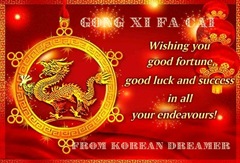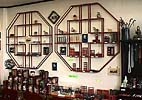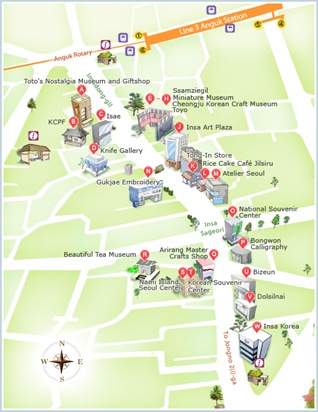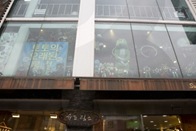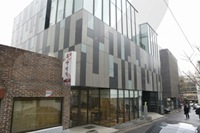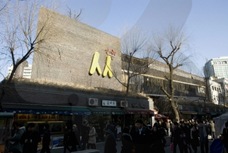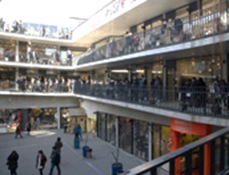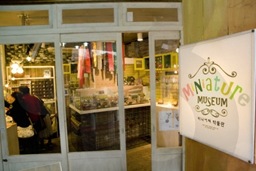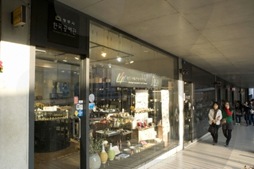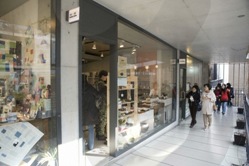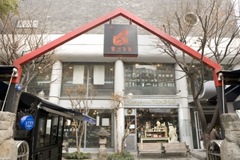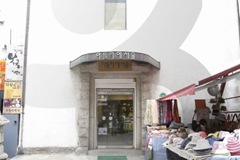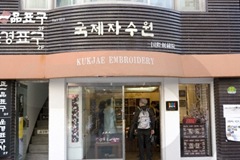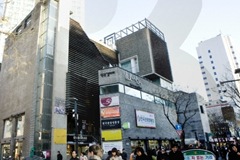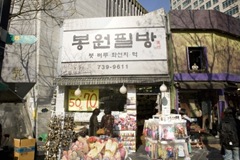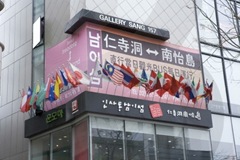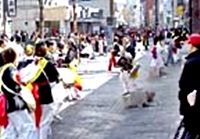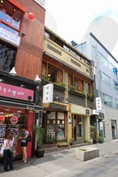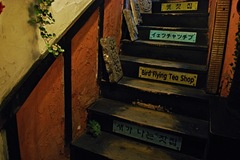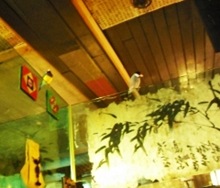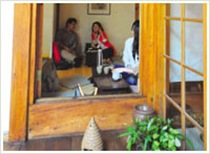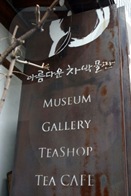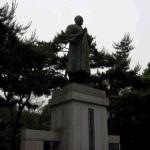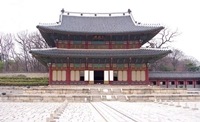Hi everyone, just a short post today to wish Happy Seollal to my Korean readers and Gong Xi Fa Cai to my Chinese readers. I know I haven’t posted anything for quite a while. Not my usual excuse of watching too many Korean dramas this time though. Actually, I have been busy taking orders and baking home-made cookies since Christmas up to now Chinese New Year helping out a friend. I haven’t had any proper sleep at all, much less watch K-dramas and write on my blog. I still have another two days to go, some last minute orders, I’m so tired. I think I have to take a little vacation after this. So hopefully I shall start blogging again after that.
KOREAN DREAMER
" Keep your heart open to dreams. For as long as there's a dream, there is hope, and as long as there is hope, there is joy in living."

Friday, January 20, 2012
Monday, December 5, 2011
Strolling down a historical street in Seoul.
This week I am going to take a break from treasure hunting and take you all exploring one of the most famous streets in Seoul instead. How would you like to experience true traditional Korean culture? Where? Where else but in Insadong, for nowhere else exudes more local and traditional charm than Insadong, a quaint neighborhood in the center of Seoul. The streets of Insadong are just alive with traditional culture. Insa-dong-gil stretches over 700 meters between the Anguk-dong Rotary and Tapgol Park (Jongno 2-ga). Actually, the area that is now known as Insadong has been the center of culture since the Joseon era. During the Joseon Dynasty (1392-1910), the street was dominated by Dohwawon, a place of study for painters.
The area is still a center for the arts, and painters, craftsmen, and art lovers continue to set up shop along the narrow alleys, making it a unique place showcasing folk crafts, pottery, and paintings. It is also one of the best places in Korea to pick up high quality souvenirs. Here you can find all manner of items that are unique only to Korea, such as wooden masks, fashionable Hanboks, and items made with hanji or Korean traditional paper.
Insadong’s streets are lined with shops selling traditional Korean craftwork that have been handcrafted or painted by the owners themselves. Everything from tea sets, wooden masks, furniture and artwork can be purchased here, but at slightly higher prices due to their quality and authenticity.
How to get there? Take subway line number 1 to either Jonggak Station or Jongno 3-ga Station and go out through Exit #5. You may also take the subway line number 3 to Anguk Station and exit at Exit #6.
The main street, Insadong-gil can be quite congested with tourists but don’t let that put you off. Be a bit adventurous, and explore the many narrow side alleys hidden away from the main street, as in Insadong, every turn you make is a new discovery. But make sure you pick up a map of the area from one of the three Tourist Information Centers first, so that you won’t get lost.
If you look at the road map of Insadong above, you will see the important landmarks/shops along this street, marked by the letters of the alphabet, so I shall tell you a little about these places first and the type of things they sell, so that you can plan out your shopping itinerary instead of just going aimlessly into every shop.
A. Toto's Nostalgia Museum and Gift Shop is a museum that displays items that were common in Korea in the 1960s and 1970s. After paying the entrance fee (1,000 KRW), visitors will find themselves surrounded by toys, snacks, and other items of the past, such as Jjondgi and Apolo.
B. Korean Craft Promotion Foundation (KCPF) Master Craft Shop displays and sells high-quality Korean handicrafts, stamped with the UNESCO Seal of Excellence for Handicrafts. The shop possesses handicrafts by renowned master craftsmen and artists.
C. Isae. Targetting middle-aged customers and senior citizens, Isae only uses chemical-free fabrics made especially with functional comfort in mind. Both modern and traditional hanbok styles are available here
D. Knife Gallery is the only knife specialty shop in Korea, this Insadong gallery is home to over 6,000 knives from all over the world. They include traditional Korean and Japanese knives, Chinese knives, decorative knives, knives by some famous artists, and knives shown in movies. There are a variety of knives for both daily and decorative uses. Customers who order custom knives may observe the entire manufacturing process.
E. Ssamziegil is a unique cultural shopping complex that continues the traditions of Insa-dong while complementing it with modern convenient facilities. It’s where the old meets the new.
Crowded every weekend, it is one of the main attractions of Insadong. It's an open-air structure that contains five floors of shops, with over 70 stores that sell various items, ranging from fashion and art to food and accessories. Performances and exhibitions are regularly held on the first floor yard
This unique area was designed in such a way, that by connecting its alleys it takes the form of a spiral-like stairway. The building's name, Ssamziegil, comes from this spiral structure, making one continuous path that is lined with craft shops like one of the streets in Insadong. From the top, at Haneulmadang, you can get an extraordinarily clear view of the sky.
Six different design studios have come together at Ssamziegil Workshop located on B1 to offer their expertise in their fields to teach their crafts to the public, at a low cost. Cerawork, ceramics hand painting; Sudesign, mother of pearl and wood; Gongye Design, Korean paper-craft; Beads&clay, beads and clay; Hyang-youn, aroma candles and ribbon; and Yeson; natural soaps and leather.
Why not take a crash course on how to make natural soap. It’s easy; just pick out a mold for your soap, the color, and the oils. Mix it all together and let it set for about an hour, meanwhile you can continue to shop around and come back to collect it later. It will be all wrapped up and ready for you to take delivery and it costs no more than 4,000 won for your own personalized soap.
F. Miniature Museum sells a diverse selection of miniature key rings, mobile phone accessories, and business card holders that are sure to please both children and adults. Miniature pottery is also available for purchase.
G. Cheongju Korean Craft Museum displays and sells Korean crafts made by artists in Cheongju. It is home to over 100 different kinds of crafts including crafts related to Jikji (the oldest remaining book in the world using the metal printing method). Customers are exposed to rich information on Jikji and the International Craft Biennale. Main products include neckties (using metal printing), pottery, textile crafts, jewelry, and products using Korean traditional patterns and handwritings.
H. Toyo specializes in pottery for daily use such as mugs, plates, and tea cups. Crafted by Sonnae Pottery (a pottery village in Jinan, Jeonbuk), pottery in Toyo demonstrates sophisticated simplicity and elegance. Guests can also view pottery for decorative purposes. The Sonnae Pottery was honored with the 2008 UNESCO Seal of Crafts Excellence in East Asia.
J. Insa Art Plaza is a giant shopping mall that deals with everything Korean: traditional crafts made by artists, daily use pottery, lacquer-ware, hanji (traditional Korean paper) crafts, silver/pearl/crystal accessories, mobile phone key rings, scent pouches, traditional teas, rice cakes, traditional chopsticks and more. Customers can purchase high quality products at reasonable prices at Insa Art Plaza.
K. Tong-In Store is not only the oldest specialty shop in traditional crafts, but also offers diverse contemporary crafts. It operates both a shop and gallery. The store is heavily involved in nurturing artists and, often, displays their works in its gallery. Its crafts cover all types, promoting craftsmanship to both citizens and tourists.
L. Jilsiru is a modern cafe serving traditional snacks. Customers may enjoy the wide variety of tteok (rice cake), hangwa (Korean traditional sweets & cookies), and traditional organic beverages at this cafe with a sophisticated interior.
M. Park Young Sook Bedding (Atelier Seoul) is the gallery of the modern potter, Park Young Sook. It displays and sells white porcelains representing the Chosun Dynasty, Buncheong ware, and ceramics with modern flavors. Various items include flower vases, decorative ceramics, and daily use earthen ware.
N. Gukje Embroidery specializes in embroidered crafts using Korean traditional patterns. Every product is handcrafted, delicate, and elegant. It is a frequent destination of foreign dignitaries. It offers workshops where international tourists can learn how to make embroidered crafts.
O. National Souvenir Center is a duty free shopping complex that sells Korean souvenirs, including crafts, pottery, lacquer-ware inlaid with mother-of-pearl, traditional food items, and Korean celebrity memorabilia. Visitors can expect to find items that are made by renowned local artists as well as of cultural and historical significance.
P. Bongwon Calligraphy has provided customers with top-notch calligraphic supplies for over 30 years. Products are reasonably priced because the shop deals in both the manufacture and sales. Being one of the largest of its kind in Insa-dong, the shop is frequented by calligraphic experts. Customized products are available upon request.
Q. Arirang Master Crafts Shop is a comprehensive shopping center dealing with Korean traditional crafts. It covers traditional crafts by famous artists, pottery for daily use, decorative pottery, lacquer ware inlaid with mother-of-pearl, crafts made of Korean traditional paper and more. In addition, customers can enjoy the works displayed in the Migak Museum (Migak means delicate sculpture for eyes to see), located in the shop.
| R. Beautiful Tea Museum offers teas from around the world and shows items depicting international tea cultures. It displays teas, tea-related items, and ceramics made by young artists. 130types of teas from Korea, China, Japan, Taiwan, Sri Lanka, and European countries can be found in the museum. There is also a café offering delicious teas. S. Nami Island Seoul Center in Insa-dong was opened to promote its tourist attractions and guide international tourists to the island. The center offers ceramics and glass crafts produced in Nami Island. It also sells character products related to the famous soap opera Winter Sonata. The tour bus departs from Insa-dong at 9:30 a.m. and returns at 4 p.m. T. Korean Souvenir Center offers representative Korean souveniors. It deals with certified high quality products that have won craft/souvenir contests held by national organizations such as Korean Tourism Organization. Its third floor houses Namisum (Nami Island) Seoul Center which has attracted many Japanese tourists in recent years. Products on sale here are embroidered products, lacquer-ware, ceramics, naturally dyed products, amethysts, traditional crafts, and character products (Korean entertainment stars) U. Bizeun - Insadong Branch, is a cafe that serves as many as 250 different types of Korean traditional rice cake. Conveniently located alongside a myriad of souvenir stores in one of Seoul's most popular tourist attractions, Bizeun - Insadong Branch offers a wide variety of rice cake and rice pastries. The store also serves such traditional drinks as sikhye (rice punch), sujeonggwa (cinnamon punch), and different types of tea, as well as frozen beverages.Forty percent of all antique stores in Korea can be found in Insadong. That is quite an astounding number for just one small neighborhood. But as you begin to explore the tiny alleys shooting off from the main street you start to realize that this is just the beginning. As you continue to wander around the alleys and byways of Insadong you will find stores selling old books, pictures and calligraphy. You will also undoubtedly find old photographs, pottery, wooden containers, jewelry, ceramics and earthenware. Things may be a little expensive in Insadong, but you can't beat the atmosphere or the convenience elsewhere. There is no shortage of stores selling souvenirs and facsimiles of traditional Korean cultural items. However, when shopping in Insa-dong, make sure you check where the product is made in. Recently, cheap Chinese goods such as teacups, wall tapestries, and small accessories have been brought into the Insa-dong markets and have spurred cases where merchandise thought to be made in Korea turned out to be marked as ‘Made in China.’
During the weekends, the streets will be closed to vehicles, and cultural festivities like parades, traditional wedding processions, traditional musical and dance performances, will be held in the streets to attract the locals as well as the tourists. It is a pleasant, fun place to shop and wander around in.
A tour of Insadong is not complete unless you have stepped into a traditional Korean teahouse or chatjip. Long renowned for its traditional tea shops, Insadong has increasingly become overrun with more modern versions. However, local merchants have been fighting to keep alive the old traditions, and many traditional tea houses still survive, many playing old folk music. Several restaurants offer traditional recipes in authentic settings. Explore the side alleys for the best ones, and I’ve got a few recommendations for you to try. These enchanting places are a unique blend of tastes, aromas and sounds, brought together in a traditional Korean setting. Drinking hot tea with Korean snacks , whilst enjoying the ambience of the teahouse is most relaxing for the mind and body. It’s as if you are in another world altogether. Price? This is the average price list, but at some places, they may be higher. Hot Tea : 7,000 won
There is this place called ‘The Old Tea Shop.’ which is in the small alley between Temple Food Shop and Atelier Seoul. At the end of the alley you will see the Old Tea Shop. Bird Flying Tea Shop is on the 2nd floor. The shop is actually divided into two parts. The downstairs (ground level) tea shop does not have birds flying around. You have to climb up a winding staircase to reach it and when you are there, you’ll be in for a big surprise.
This little tea shop is full of little colorful birds everywhere. Some are flying in the air, whilst some are perched on the windowsills and there are some who even come and walk on the tables you’re sitting at, foraging for free crumbs I suppose. So you’ll be drinking your favorite tea with the incessant chirping of the birds coming from every corner of the room. It’s like music to the ears. Another thing unique about this place is the antique furniture and other knick knacks that adorn this place together with the low-lit lamps.
One of Seoul’s most popular Korean traditional teahouses is Dawon, located in the garden of Kyungin Museum of Fine Art. In spring, when the garden transforms into a riot of cheerful colors, this is a truly magical place to visit. You can have your choice between sitting in the outdoor courtyard or in the beautiful Korean hanok itself. You’ll probably opt for the courtyard, where you can drink your tea in the refreshing spring breeze. At night, the Korean hanok is beautifully lit up, making it a perfect rendezvous spot.
To those just passing by, Insa-dong Teahouse doesn’t look like much. This might be a good thing — if people knew what awaited them inside, it’d be packed all the time. Hidden away from the main drag of Insa-dong, Insa-dong Teahouse has a lovely Korean-style courtyard, or madang, surrounded by a Korean hanok-style home. Visitors may sit in either the courtyard or the hanok — in spring or summer, the courtyard makes for an especially pleasant tea-sipping venue. The hanok rooms are relatively spartan in that charmingly Confucian way. It’s a very relaxing place that doesn’t get quite the attention it deserves.
O'sulloc's is a bit of an institution here in Seoul that specializes in green tea. They even grow their own tea in their tea plantation in Jeju. But it can be quite pricey here as compared to the more traditional teahouses though. From "Brownies" and Ice Cream made from green tea, you can find almost any type of tea here. The green tea patbingsu or Green Tea Sherbet is an absolute must try at this place. What is patbingsu? It is the Korean summer dessert, shaved ice topped with sweetened azuki beans, ice cream and fruits. The green tea patbingsu here, comes with dried fruits and red beans, topped with green tea ice cream. It costs 17,000 won but it’s quite huge. Worth trying if you're not on a budget but there are other places that sell green tea patbingsu for probably much less.
The Beautiful Tea Museum exhibits porcelain artwork by young ceramists. It also offers a large variety of world tea from Korea, China, Japan, Sri Lanka, India, Europe and more, totaling 130 types of tea. The museum not only exhibits tea, but it also provides a café for visitors to relax and enjoy the taste of their selected tea. The Beautiful Tea Museum exhibition of tea-items is divided into three sections; Korea, China, and Tibet. Visitors can gain an overall understanding of the tea traditions of each country. Also, young ceramists’ artwork is up for sale. I hope that you have enjoyed your visit to Insadong today. See you again soon. Special thanks and appreciation to the following: http://visitkorea.or.kr/enu/SH/SH_EN_7_2_2_1.jsp http://english.visitkorea.or.kr/enu/SI/SI_EN_3_6.jsp?cid=731514 http://visitkorea.or.kr/enu/SI/SI_EN_3_1_1_1.jsp?cid=1065462 http://www.lifeinkorea.com/Travel2/9
|
Thursday, November 10, 2011
Jongno, here we come!
By the way I forgot to explain what I meant when I said that I was going on a National Treasures hunt. By National Treasures, I mean the numbered set of tangible treasures, artifacts, sites, and buildings which are recognized by South Korea as having exceptional artistic, cultural and historical value.
Many of the national treasures are popular tourist destinations such as the Jongmo Royal Ancestral Shrine, Bulgaksa, Seokguram and the Tripitaka Koreana at Haeinsa.. The treasures are numbered according to the order in which they were designated and not according to their individual value.
So, what say you if we start with National Treasures #2, the 10 Storied Stone Pagoda of Wongaksa at Tapgol Park?
Tapgol Park is a small (4.84 acre) public park located here at Jongno-gu, Seoul. It is historically important because it was the site of the founding of the March1st Movement 1919, (an important part of the Korean Independence Movement) and also as the location where the Declaration of Independence was first read out.
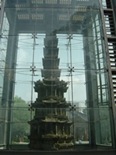
It was previously the site of a 15th century Buddhist temple, and a 10 storied stone pagoda and a few relics of the temple still can be seen in the park. The Wongaksa Pagoda, dating from 1467 as one of the finer examples of pagoda art during the Joseon era, is encased in a thick protective shielding.
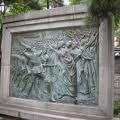
There are a number of bas-relief statues representing Korean patriots, the Declaration of Independence Monument, and a poem by Han Yong-un. It is like an open air museum.

One of the monuments in the park is the Monument of Wongaksa built in 1471 to record the founding of Wongaksa (temple) in 1465. The turtle shaped base is constructed from granite and the body is cut from marble. The monument measures 1.3 meters wide and stands 4.9 meters in height. Two elaborately carved intertwined dragons rising toward the sky holding a Buddhist gem reside on the top of the monument.
On the front is an inscription composed by Kim Suon with the calligraphy done by Seong Im. On the back is an inscription composed by Seo Geo Jeong with the calligraphy done by Jeong Nam Jong.
From here, let’s now go to Gyeongbokgung or Gyeongbok Palace to look for our next two National Treasures, the Geunjeongjeon Hall and the Gyeonghoeru Pavilion. As I intend to write about all the palaces in more detail later on, I shall only briefly touch on the palaces and deal more on the National Treasures for now.
Gyeongbokgung which means Palace Greatly Blessed by Heaven, was built in 1395 and served as the main palace.
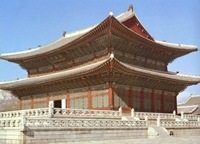
The building was constructed during King Taejo's reign in1394 and the name of the building, which was given by High Priest Jeong Dojeon, means the Hall of Government of Diligence
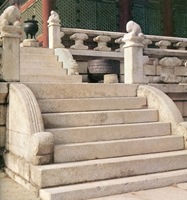
It was burnt down during the Japanese Invasion in 1592, and the present building was only rebuilt in 1867, during the reign of King Gojong. Geunjeongjeon is a two storied building that contains 5 rooms each on the front and side. The roof is "八" shaped from the side. The stone platforms in front of the hall are carved with various animal ornaments, including the12 Chinese zodiacal images.
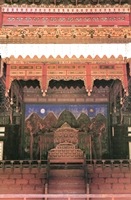
The inside of the hall is level without higher or lower floor and in the center is the throne with the sun and the moon folding screen behind it. Surrounding the Geunjeongjeon is a square corridor, two-kan wide.
At the center of the southern wing stands the Geunjeon Gate and in the stone paved spacious courtyard between this gate and the throne hall, stand on both sides of the straight paved path used by the kings, two rows of stone tablets at intervals, marked with a number to indicate the positions of rank during the royal audience.
Gyeonghoeru, National Treasures #224 is located to the left of the main building.
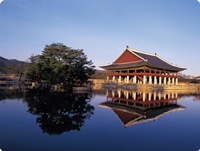
Gyeonghoeru or Pavilion of Auspicious Meeting is a two storied pavilion which stands on a rectangular stone island in a lotus lake. It was erected in the northwest side of the pond in Geunjeongjeon, Gyeongbok Palace, The upper storey was used for royal banquets during the Joseon period and is still being used today on special occasions such as the nation's liberation day reception on Aug.15.
The original building was constructed by King Taejo when Gyeongbokgung Palace was first constructed, as a two storied pleasure pavilion which was later enlarged by King Taejong in 1412, at which time the lotus lake was laid out.
It was burnt down during the Japanese Invasion in 1592, leaving only the stone supports.
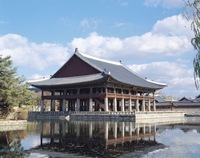
The present edifice was reconstructed in 1867 during the reign of King Gojong. Gyeonghoeru had 7 rooms in front and 5 rooms at the side and was a splendid and magnificent building.



With the reconstruction, square pillars were erected outside, while circular pillars were erected inside. The lower floor is open and has 48 stone pillars, carved with dragons wider at the bottom than at the top, set in eight rows of six columns each.
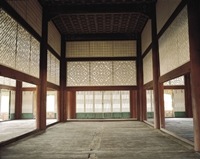
The lower floor was made of stone, whilst the upper floor had a wooden floor. The upper room floor was not level but elevated so that officials could sit according to their respective ranks/positions. The roofs were made up of a set of decorative roof tiles over the angle rafter.
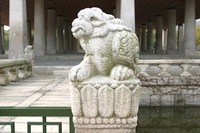
The pavilion is connected to the shore land by three stone bridges. Animal figures were carved on the bridge and its railings. Behind the pavilion, a man-made hill called Amisan, was constructed using the soil that was dug out to make the pond.
This simple and yet splendidly designed pavilion is considered as a valuable cultural asset, representing the work style of the late Joseon Dynasty.
If you only have time to visit one palace then make it this one as it’s the mother of all palaces. Within the vicinity are the National Folk Museum and the National Palace Museum which are included free in the admission ticket to the Gyeongbok Palace.
In case you are interested to come back on your own to spend more time at this palace, I’m including some info for you.
Palace admission: 3,000 won.
Open Wed. - Mon. from 9 am - 6 pm (Mar. - Oct.) or 9 am - 5 pm (Nov. - Feb.).
Open until 7pm on Weekends and National Holidays (May to August only).
Closed Tuesdays
Free Guided Walking Tours:
English at 11am, 1.30pm and 3.30pm
Japanese at 10am, 12.30pm and 2.30pm
Chinese at 10.30am, 1pm and 3pm
Changing of Guards:
Every hour from 10am to 4pm

Since the entrance ticket to Gyeongbokgung includes free entrance to the National Palace Museum, we might as well go in to see National Treasures #310, Large Porcelain Jar.
White porcelain jars of this type were produced for about a century, from the latter half of the 17th century to the early half of the 18th century, at kilns run by the Office of the Royal Kitchens (Saongwon), particularly those in Geumsa-ri, Gwangju, Gyeonggi-do Province.
These voluminous round jars with a pure, rich ambience are usually over 40cm in height and have a milky white glaze. They are often called "moon jars." This jar is 43.8cm tall and 44cm in diameter. The diameters of the mouth and the base are in ideal proportion and give the vessel a stable appearance. The jar is slightly asymmetric and warped, which contributes to the overall vibrancy of the vessel form rather than impairing its beauty. The glaze is smoothly melted into the clay.
Given their large size, porcelain jars of this style were formed in two hemispheres which were joined together. It was a precarious job requiring deft hands. Firing also needed high expertise.
The unassuming aesthetic of these jars typified the porcelain art of the Joseon Dynasty (1392-1910). Most outstanding examples are dated to the early part of the 18th century. During the peak years there were some 340 kilns in the Gwangju area alone.
Let’s now go to another palace, the Changdeokgung to take a look at the Injeongjeon Hall, National Treasures #225.You are going to love this palace, and there’s even a secret garden.
Incidentally, for those of you who watched the drama Dae Jang Geum or Jewel in the Palace, parts of this palace were used in the filming of the drama.
I hope that you ladies have comfortable walking shoes on, as there’s a bit of hill climbing to be done here since the palace is on hilly ground.
Changdeokgung was built as a secondary palace in 1405 during the reign of King Taejong, but which was to become the main palace later on. The meaning of the name Changdeokgung is "Palace of Prospering Virtue". Changdeokgung was the most favored palace of many princes of the Joseon Dynasty.
Gyeongbokgung and Changdeokgung were totally destroyed by fire during the Japanese invasion of 1592. After the war, only Changdeokgung was restored in 1610, during the reign of King Gwanghaegun and served as the main palace for the next 258 years, to become the longest functioning main palace in Joseon history.
The layout of Changdeokgung is unique in that it is situated on the slope of Mt Bukgaksan and the palace is special in that it does not overlook any of the major streets of the capital like the other palaces. Ironically, the less majestic placement of the Changdeok Palace adds to its aesthetic value.
Changdeokgung may be one-third the size of Gyeongbokgung, but the beautiful natural landscape it is endowed with makes up for any shortcomings due to its size. In most of the other palaces, the grandeur of the throne hall can usually be seen immediately after walking through the main gate. This is where Injeongjeon Hall, the throne hall of Changdeok Palace, is different. It is situated to the right of the palace down the main avenue and then, to the left. At a glance, the palace appears to be a bit disorganized, but when examined from a topographical perspective, its setting flows in continuous harmony with the natural terrain. Instead of clearing away large hills, the palace buildings were instead built around them. Pavilions were built nestled in between the trees and gorges, to ensure that there was no interference to the overall landscape.
Behind the palace lies the Huwon (Rear garden) which was originally constructed for the use of the royal family and palace women. It was first landscaped in 1623 and served for centuries as a royal retreat.
The garden incorporates a lotus pond, pavilions, and landscaped lawns, trees, and flowers. The surroundings and the palace itself are well matched. There are over 26,000 specimens of a hundred different species of trees in the garden and some of the trees behind the palace are now over 300 years old. The garden that was a very private space for the king had been called 'Geumwon' (Forbidden garden) because even the high officials did not dare to enter without the king's invitation. Today Koreans often call it 'Biwon' (Secret garden) Though the garden had many other names, the name most frequently used in those days was 'Huwon'.
A variety of ceremonies hosted by the king were conducted here, amongst them, the holding of feasts, having firework displays, and even participating in sporting events like archery.
Injeongjeon was the main hall of Changdeokgung. The kings conducted state affairs, held national ceremonies and received foreign officials here. It was equipped with various decorations that symbolized the formality and diplomacy of the palace in the Joseon Dynasty. When the Crown Prince was proclaimed, or there was a national celebration, the king was congratulated by the officials in Injeongjeon.
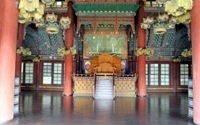
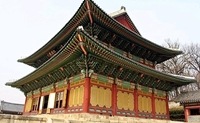
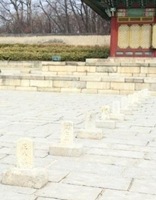
As usual,there were the stones lining the courtyard of Injeongjeon Hall to serve as markers to place civil and military officers during official ceremonies.
The floor, lighting, curtains, glass windows were only modified to a Western style in 1908.
According to the theory of Pungsoo (geomancy), the setting of the Injeongjeon Hall is comparable to the bud of a Japanese apricot, which is a flower that hangs from the boughs of the trees that grow on the Baekdudaegan, the biggest mountain range on the Korean Peninsula.
It had been repaired several times and the present state of the building was built in 1804 during the reign of King Sunjo .

Where to next? There’s a palace right next door, why don’t we have a look there? Changgyeonggung’s Myeongjeongjeon Hall, National Treasures #226 is what I have in mind. Together with Changdeokgung, which is separated from Changgyeonggung by just a stone wall, the palace used to be called “Donggwol or eastern palace”.
Myeongjeongjeon Hall is the main building in Changgyeonggung and is the oldest royal office hall of Joseon remaining to date. Myeongjeongjeon was erected to face east, instead of facing south like main buildings of other palaces do; this is believed to be because of the unique topographic characteristics of the land on which Changgyeong Palace was built.
Built as “Suganggung” by King Sejong the Great for his father, King Taejong, this palace was renovated and enlarged by King Seongjong in 1483, for his grandmother, mother and an aunt.
As compared to the Geunjeongjeon in Gyeongbokgung and the Injeongjeon in Changdeokgung which were large buildings, Myeongjeongjeon was just a small sized, single-story building.






It contained 5 rooms in the front and 3 rooms at the side, while the roofs were '八' shaped.
Pillars, supporting the eaves, were not only placed on the top of the pillars but also between pillars, called the "multi-beam style." They were soundly constructed without decoration which was the typical style of the early Joseon Dynasty,
Behind the throne, there was a folding screen known as the Irworoakdo which was embroidered with figures of the sun, the moon, and the five famous mountains in Korea.
In front of the stairs outside the building, there were 24 platforms, indicating the rankings of the government officials.
Myeongjeongjeon Hall, Myeongjeongmun Gate and Honghwamun Gate are examples of the architectural styles popular in 17th century Joseon. Carvings at the two tips of the rooftop of Honghwamun Gate and sculptures arranged along the smoothly curved gable ridge added an air of authority to the royal palace.
Again we shall take advantage of the included free admission to the Jongmyo Royal Shrine that comes with the entrance ticket to Changgyeonggung. There’s an overpass that leads to our next destination, the Main Hall of Jongmyo Royal Ancestral Shrine, National Treasures 227.
Guided foreign language tours are offered twice a day, the palace is open to the public, every day except Saturdays.
When King Taejo, the founder of the Joseon (Chosôn) dynasty, established his rule in Seoul, he built Jongmyo to honor his ancestors in a proper, filial way according to the dictates of the new ideology, Neo-Confucianism. Jongmyo also served as a model for the ancestral rites the people were expected to perform. The Neo-Confucian literati, who held the real power, wanted the people to turn away from the traditional Buddhist mourning rites toward Neo-Confucian ones. They ordered the yangban nobility to build miniature shrines in their homes, but the rule was often ignored in the early years. Later, as Neo-Confucianism gained ground, the shrines were carefully tended to in every household.
Jongmyo was completed in 1395. The grounds were planted with a solemn dignity. No excess ornamentation was permitted, nor were the buildings meant to overawe. The most precious objects enshrined here were the ancestral tablets of the King and his successors. During the Japanese invasions of 1592-1598, the tablets were kept for a time in the house of a commoner, but were returned here after reconstruction in 1608
As the Joseon dynasty unfolded, Jongmyo became the scene of a yearly ceremony in which the current King honored his seven previous male ancestors. Royal merit subjects might also be remembered in a separate hall, as were remote ancestors. Close relatives of the King and Queen in line for the throne who died without receiving it were often posthumously awarded the title. Every time a living King or Queen died, their names were recorded on a wooden tablet and installed in the Chongjon building. Active use ended in 1910 with the Japanese occupation.
Jongmyo Shrine served as the venue for the royal ancestral rites during the Joseon period. The construction of the Jongmyo Shrine was completed in 1395 before that of the main palace, Gyeongbokgung. Jongmyo Shrine is the supreme shrine of the state where the tablets of royal ancestors are enshrined and memorial services are performed for deceased kings and queens.
49 tablets, including those of 19 Joseon Kings, from its first, Taejo, to its last, Sunjong have been enshrined in Jeongjeon. Another 34 including four of Taejo’s ancestors, posthumously designated monarchs and the kings and queens were moved from Jeongjeon to the Hall of Eternal Peace, which was built in 1421 after the Main Hall ran out of space.
Subsequently, the two buildings were expanded several times resulting in their uniquely long linear shape today.
In addition to the two shrine halls, the Jongmyo compound has various halls that were used when preparing for the rites. The layout and structures of Jongmyo Shrine are very simple. The spirit chambers inside the halls where the spirit tablets are enshrined are decorated inside but the shrine halls have minimal adornment and project a sense of dignity and solemnity.
The Main Hall (Jeongjeon) is listed as National Treasure No. 227 and is the longest building of traditional design in Korea.
The image of Jeongjeon Hall viewed from the Nam-mun, the main gate, holds the beauty of a simple black tiled roof top and presents a formal calmness. The Jeongjeon Hall has asymmetric dimensions of101 meters long to the side on a foundation to 110 meters wide and 70 meters vertically.
The Jeongjeon Hall was meant to be built this way to serve its unique function during the Joseon Dynasty. Yet, another aesthetic perspective has been added to the structure. The Jeongjeon Hall had 25 kan (compartments) with 19 Kan for the ancestral tablets and 3 kan of spacing compartments on each end. The original design had only 7 kan when King Taejo ordered its construction, however, as the dynasty passed throne after throne through 500 years, the Jeongjeon Hall had to be extended at the ends to accommodate more tablets of deceased royalty, and maintain the divine order of the Dynasty’s ancestral tablets.
There were four major extensions to the original structure that led to the current configuration of the Jeongjeon Hall. These major extensions notwithstanding, the Jeongjeon Hall has maintained its original structural integrity of one complete building. It features different architectural styles shown in the extensions while maintaining the beauty of the uniformed integrity of the building.
The unique design of the Jongmyo Shrine is not even found in China, where the shrine for dedicating ancestral tablets of monarchs originated. The Jeongjeon Hall was the biggest wooden structure of one unit in the world when it was built and extended. It is regarded as the archetypal architectural structure of the Joseon Dynasty, possessing superb artistic value.
Ceremonies for deceased ancestors were the most important of all rites according to the Confucian way of thinking. The ceremonies were presided over by the King and served as a model for all sacrificial rites in the dynasty. The ceremony has three distinct phases:
1. Welcoming of the Spirits
2. Entertaining them
3. Ushering them out
Previously, the ceremony was held five times a year, but since 1971, it has been reduced to only once a year, which is on the first Sunday in May.
National Treasures #265, Avatamsaka sutra part 13 belonging to Kim Jonggyu can be found at the Samsung Publishing Museum.
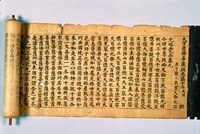
Daebanggwangbul Avatamsaka Sutra or in short, the Avatamsaka Sutra is one of the books that have the greatest influence in the establishment of Korean Buddhist philosophy.
This is Book No. 13 among the 80 books of the original edition of the Avatamsaka Sutra translated by Silchananta of the Tang Dynasty of China.
It is a part of the Tripitaka Original, which was made during the reign of King Hyeonjong (1011~1031) of the Goryeo Dynasty in an attempt to counter an aggression by the Kitan on the strength of Buddha.
The book is produced by woodblock printing on mulberry papers and designed to be stored in the form of a scroll.
It is made by joining in a row 24 pieces of paper, each of which is 46.3 cm long and 28.5 cm wide. There are several differences between the Tripitaka Original and the Tripitaka at Haeinsa Temple (also known as the Tripitaka Second or the Tripitaka Koreana), which were produced later.
The former has more sophisticatedly carved wood blocks than the latter. It contains a smaller number of characters, whilst not showing the year of production. Pihwi, a way of expressing respect by omitting a stroke from the letter or replacing it with a synonymous word when a letter in the name of the preceding king appears, and abbreviated characters are found in several places.
In addition, the Tripitaka Original often uses the words 'Jang' and 'Pok' to indicate the chapters in the books, whereas the Haeinsa Temple version uses a uniform expression of 'Jang' (using a different Chinese character).
The total number of characters in a line in this book is only fourteen, whereas in the Haeinsa Temple version each line contains seventeen characters . The last stroke in the character 'Gyeong' is omitted.
This book was published sometime between the 11th and 12th century, when the Tripitaka Original was made.
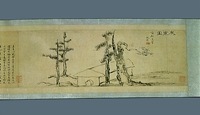
There is still one more national treasure to be found in Jongno-gu, the Wandangsehando (Landscape in winter painting by Kim Jeonghui, National Treasures #180, belonging to Son Changgeun. I can only describe it to you but I’m afraid I do not know where it is kept. Does anyone know?
As a follower of Park Jega, who was an eminent literati painter as well as a social reformist advocating to learn practical science from Qing of China, Wandang (who’s also known by another pen name, Chusa) Kim Jeongheui (1786~1856) researched epigraphy under the influence of bibliographical study of Chinese classics.
As a famous literati painter, Kim Jeongheui created his own calligraphy called Chusache. As his representative piece of artwork, this picture "Wandang Sehando" (69.2 cm x 23 cm) was drawn while he was living in exile in Jejudo Island.
In the corner of the picture, there is a description in his own writing revealing that this is a gift in return for the valuable books sent by His follower Yi Sangjeok who was staying in Peking, China.
The two ever-green trees in the picture symbolize their ever-lasting strong ties between the two people as a teacher and a student. This picture depicts one snow-covered cottage with the pine tree on the left and the cone pine tree on the right.
The remaining space is left empty with the intention of emphasizing the virtue of living simple and temperate.
On the right upper part, with the title of "Sehando", he wrote his pen name, "Wandang" along with his seal. Through his technique of brushwork rather rough and dry, he depicted the scene of the snowy winter clear and serene. Opposed to the social trends resorting to showy artifice, Kim Jeongadheui remained faithful to his own principle by emphasizing the importance of virtue of extreme temperance.
This picture is highly valued as the most representative one among the late Joseon Era literati paintings.
What a productive day we’ve had today, we managed to unearth 9 National Treasures here in Jongno-gu.
And so we have come to the end of our visit to Jongno-gu. I thought of taking you all to Insadong for some shopping but it looks like it will have to be put on hold until next week. I don’t think you’ll have the strength to walk some more after that amount of walking we did today.
So hope to see you again next week.
Special thanks and appreciation to the following:
Photos and articles © courtesy:
http://www.exploringkorea.com/tapgol-park/
http://en.wikipedia.org/wiki/Tapgol_Park
discoveringkorea.com
http://visitkorea.or.kr/enu/SI/SI_EN_3_1_1_1.jsp?cid=264350
http://jikimi.cha.go.kr/english/search_plaza_new/EMapResultView.jsp?VdkVgwKey=11,01800000,11&queryText=(v_esidocode=11%3Cand%3E%20v_elcto=11)&requery=&strGuCode=11&strSidoCode=11
http://jikimi.cha.go.kr/english/search_plaza_new/Directory_Imageall.jsp?VdkVgwKey=11%2C02260000%2C11&queryText=%28v_esidocode%3D11%3Cand%3E+v_elcto%3D11%29

